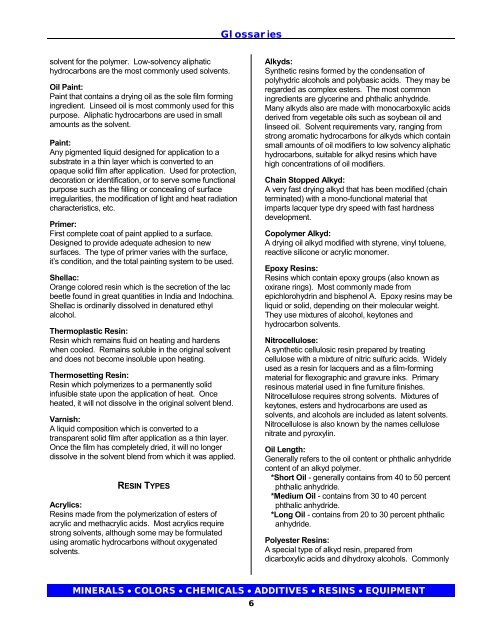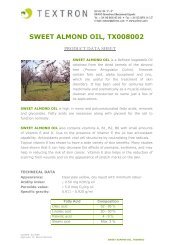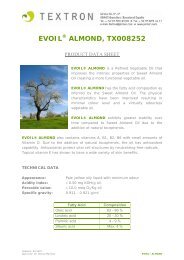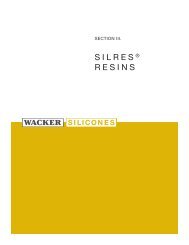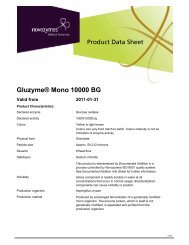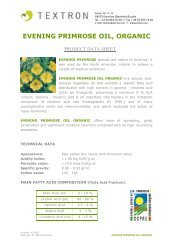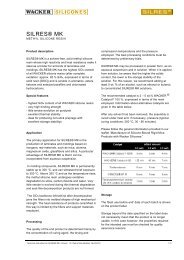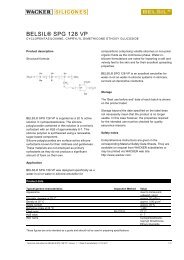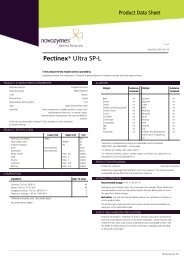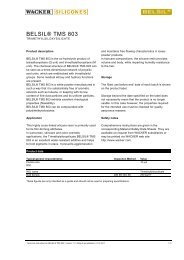Glossary of Terms - Paints and Coatings - Brenntag Specialties, Inc.
Glossary of Terms - Paints and Coatings - Brenntag Specialties, Inc.
Glossary of Terms - Paints and Coatings - Brenntag Specialties, Inc.
Create successful ePaper yourself
Turn your PDF publications into a flip-book with our unique Google optimized e-Paper software.
solvent for the polymer. Low-solvency aliphatic<br />
hydrocarbons are the most commonly used solvents.<br />
Oil Paint:<br />
Paint that contains a drying oil as the sole film forming<br />
ingredient. Linseed oil is most commonly used for this<br />
purpose. Aliphatic hydrocarbons are used in small<br />
amounts as the solvent.<br />
Paint:<br />
Any pigmented liquid designed for application to a<br />
substrate in a thin layer which is converted to an<br />
opaque solid film after application. Used for protection,<br />
decoration or identification, or to serve some functional<br />
purpose such as the filling or concealing <strong>of</strong> surface<br />
irregularities, the modification <strong>of</strong> light <strong>and</strong> heat radiation<br />
characteristics, etc.<br />
Primer:<br />
First complete coat <strong>of</strong> paint applied to a surface.<br />
Designed to provide adequate adhesion to new<br />
surfaces. The type <strong>of</strong> primer varies with the surface,<br />
it’s condition, <strong>and</strong> the total painting system to be used.<br />
Shellac:<br />
Orange colored resin which is the secretion <strong>of</strong> the lac<br />
beetle found in great quantities in India <strong>and</strong> Indochina.<br />
Shellac is ordinarily dissolved in denatured ethyl<br />
alcohol.<br />
Thermoplastic Resin:<br />
Resin which remains fluid on heating <strong>and</strong> hardens<br />
when cooled. Remains soluble in the original solvent<br />
<strong>and</strong> does not become insoluble upon heating.<br />
Thermosetting Resin:<br />
Resin which polymerizes to a permanently solid<br />
infusible state upon the application <strong>of</strong> heat. Once<br />
heated, it will not dissolve in the original solvent blend.<br />
Varnish:<br />
A liquid composition which is converted to a<br />
transparent solid film after application as a thin layer.<br />
Once the film has completely dried, it will no longer<br />
dissolve in the solvent blend from which it was applied.<br />
RESIN TYPES<br />
Acrylics:<br />
Resins made from the polymerization <strong>of</strong> esters <strong>of</strong><br />
acrylic <strong>and</strong> methacrylic acids. Most acrylics require<br />
strong solvents, although some may be formulated<br />
using aromatic hydrocarbons without oxygenated<br />
solvents.<br />
Glossaries<br />
6<br />
Alkyds:<br />
Synthetic resins formed by the condensation <strong>of</strong><br />
polyhydric alcohols <strong>and</strong> polybasic acids. They may be<br />
regarded as complex esters. The most common<br />
ingredients are glycerine <strong>and</strong> phthalic anhydride.<br />
Many alkyds also are made with monocarboxylic acids<br />
derived from vegetable oils such as soybean oil <strong>and</strong><br />
linseed oil. Solvent requirements vary, ranging from<br />
strong aromatic hydrocarbons for alkyds which contain<br />
small amounts <strong>of</strong> oil modifiers to low solvency aliphatic<br />
hydrocarbons, suitable for alkyd resins which have<br />
high concentrations <strong>of</strong> oil modifiers.<br />
Chain Stopped Alkyd:<br />
A very fast drying alkyd that has been modified (chain<br />
terminated) with a mono-functional material that<br />
imparts lacquer type dry speed with fast hardness<br />
development.<br />
Copolymer Alkyd:<br />
A drying oil alkyd modified with styrene, vinyl toluene,<br />
reactive silicone or acrylic monomer.<br />
Epoxy Resins:<br />
Resins which contain epoxy groups (also known as<br />
oxirane rings). Most commonly made from<br />
epichlorohydrin <strong>and</strong> bisphenol A. Epoxy resins may be<br />
liquid or solid, depending on their molecular weight.<br />
They use mixtures <strong>of</strong> alcohol, keytones <strong>and</strong><br />
hydrocarbon solvents.<br />
Nitrocellulose:<br />
A synthetic cellulosic resin prepared by treating<br />
cellulose with a mixture <strong>of</strong> nitric sulfuric acids. Widely<br />
used as a resin for lacquers <strong>and</strong> as a film-forming<br />
material for flexographic <strong>and</strong> gravure inks. Primary<br />
resinous material used in fine furniture finishes.<br />
Nitrocellulose requires strong solvents. Mixtures <strong>of</strong><br />
keytones, esters <strong>and</strong> hydrocarbons are used as<br />
solvents, <strong>and</strong> alcohols are included as latent solvents.<br />
Nitrocellulose is also known by the names cellulose<br />
nitrate <strong>and</strong> pyroxylin.<br />
Oil Length:<br />
Generally refers to the oil content or phthalic anhydride<br />
content <strong>of</strong> an alkyd polymer.<br />
*Short Oil - generally contains from 40 to 50 percent<br />
phthalic anhydride.<br />
*Medium Oil - contains from 30 to 40 percent<br />
phthalic anhydride.<br />
*Long Oil - contains from 20 to 30 percent phthalic<br />
anhydride.<br />
Polyester Resins:<br />
A special type <strong>of</strong> alkyd resin, prepared from<br />
dicarboxylic acids <strong>and</strong> dihydroxy alcohols. Commonly<br />
MINERALS COLORS CHEMICALS ADDITIVES RESINS EQUIPMENT


